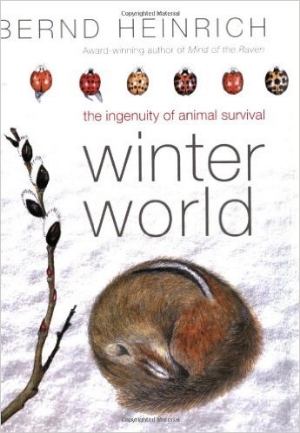

How to Fly (In Ten Thousand Easy Lessons)
I got my copy of How to Fly (In Ten Thousand Easy Lessons) by Barbara Kingsolver in the mail recently and I can't stop picking it up, flipping to a random page, and leaping off the cliff into it’s deep waters. I turn to it when the stress of Covid-19 overwhelms and my head hurts from problem-solving. The book is both an escape and a lesson at the same time.

Gathering Moss: The Natural and Cultural History of Mosses
"Living at the limits of our ordinary perception, mosses are a common but largely unnoticed element of the natural world. "Gathering Moss" is a beautifully written mix of science and personal reflection that invites readers to explore and learn from the elegantly simple lives of mosses."

The Hidden Life of Trees
For July 2017, the BRDC Book Club read and discussed The Hidden Life of Trees.
"In The Hidden Life of Trees, Peter Wohlleben shares his deep love of woods and forests and explains the amazing processes of life, death, and regeneration he has observed in the woodland and the amazing scientific processes behind the wonders of which we are blissfully unaware.

The Appalachian Forest, A Search For Roots and Renewal
For May, the BRDC Book Club read The Appalachian Forest, A Search For Roots and Renewal by Chris Bolgiano. "Steeped in history, the Appalachian wilderness has been profoundly affected by the people who have lived and worked there. This volume traces the natural history of the Appalachian forest while taking into account the people and politics that have shaped its development. Bolgiano is well qualified to write about this area, as she and her husband make their home on 100 acres of the old-growth forest.

Flight Behavior
For March, the BRDC Book Club read Flight Behavior, by Barbara Kingsolver.
"A brilliant and suspenseful novel set in present day Appalachia; a breathtaking parable of catastrophe and denial that explores how the complexities we inevitably encounter in life lead us to believe in our particular chosen truths. Kingsolver's riveting story concerns a young wife and mother on a failing farm in rural Tennessee who experiences something she cannot explain, and how her discovery energizes various competing factions—religious leaders, climate scientists, environmentalists, politicians—trapping her in the center of the conflict and ultimately opening up her world. Flight Behavior is arguably Kingsolver's must thrilling and accessible novel to date, and like so many other of her acclaimed works, represents contemporary American fiction at its finest."

Hillbilly Elegy: A Memoir of a Family and Culture in Crisis
"From a former marine and Yale Law School graduate, a powerful account of growing up in a poor Rust Belt town that offers a broader, probing look at the struggles of America’s white working class."

Coyote Settles the South
"One night, poet and environmental writer John Lane tuned in to a sound from behind his house that he had never heard before: the nearby eerie and captivating howls of coyotes. Since this was Spartanburg, South Carolina, and not Missoula, Montana, Lane set out to discover all he could about his new and unexpected neighbors."

Lab Girl
"Lab Girl is a book about work, love, and the mountains that can be moved when those two things come together. It is told through Jahren’s remarkable stories: about her childhood in rural Minnesota with an uncompromising mother and a father who encouraged hours of play in his classroom’s labs; about how she found a sanctuary in science, and learned to perform lab work done “with both the heart and the hands”; and about the inevitable disappointments, but also the triumphs and exhilarating discoveries, of scientific work."

The Invention of Nature: Alexander von Humbolt's New World
The acclaimed author of Founding Gardeners reveals the forgotten life of Alexander von Humboldt, the visionary German naturalist whose ideas changed the way we see the natural world—and in the process created modern environmentalism.

Bringing Nature Home
"Chances are, you have never thought of your garden — indeed, of all of the space on your property — as a wildlife preserve that represents the last chance we have for sustaining plants and animals that were once common throughout the U.S. But that is exactly the role our suburban landscapes are now playing and will play even more in the near future." Doug Tallamy

Bernd Heinrich's Winter World
From flying squirrels to grizzly bears, and from torpid turtles to insects with antifreeze, the animal kingdom relies on some staggering evolutionary innovations to survive winter. Unlike their human counterparts, who must alter the environment to accommodate physical limitations, animals are adaptable to an amazing range of conditions.

Wandering Through Winter
"Edwin Way Teale (June 2, 1899 – October 18, 1980) was an American naturalist, photographer and Pulitzer Prize-winning writer. Teale's works serve as primary source material documenting environmental conditions across North America from 1930 - 1980. He is perhaps best known for his series The American Seasons, four books documenting over 75,000 miles (121,000 km) of automobile travel across North America following the changing seasons."

(July 2015) American Chestnut: The Life, Death, and Rebirth of a Perfect Tree, by Susan Freinkel
"The American chestnut was one of America's most common, valued, and beloved trees—a "perfect tree" that ruled the forests from Georgia to Maine. But in the early twentieth century, an exotic plague swept through the chestnut forests with the force of a wildfire. Within forty years, the blight had killed close to four billion trees and left the species teetering on the brink of extinction."

(June 2015) The Forest Unseen: A Year's Watch in Nature, by David George Haskell
Biologist David George Haskell uses a one-square-meter patch of old-growth Tennessee forest as a window onto the entire natural world. Visiting it almost daily for one year to trace nature's path through the seasons, he brings the forest and its inhabitants to vivid life. Beginning with simple observations--a salamander scuttling across the leaf litter, the first blossom of spring wildflowers--Haskell spins a brilliant web of biology, ecology, and poetry, explaining the science binding together ecosystems that have cycled for thousands--sometimes millions--of years.

(May 2015) Grandfather Mountain, a Profile, by Miles Tanger
"Many have seen it, but few people know it well. Now come visit the Grandfather Mountain in its complete history, and full stature as one of the world's great mountains. Grandfather Mountain: A Profile travels back to the origins of this living entity, then traces its unique development--geological, natural, prehistoric, and modern humans-- to the present day, where it still stands alone as the grand patriarch of the Blue Ridge Mountains."

(April 2015) Life in the Soil: A guide for Naturalists and Gardeners
Lavishly illustrated with nearly three hundred color illustrations and masterfully-rendered black and white drawings throughout, Life in the Soil invites naturalists and gardeners alike to dig in and discover the diverse community of creatures living in the dirt below us. Biologist and acclaimed natural history artist James B. Nardibegins with an introduction to soil ecosystems, revealing the unseen labors of underground organisms maintaining the rich fertility of the earth as they recycle nutrients between the living and mineral worlds.

(February 2015) The Signature of All Things: A Novel
This month's Book Club choice is the Signature of All Things by Elizabeth Gilbert. The novel follows the fortunes of the extraordinary Whittaker family as led by the enterprising Henry Whittaker—a poor-born Englishman who makes a great fortune in the South American quinine trade, eventually becoming the richest man in Philadelphia.

(January 2015) 9. Hunting from Home: A Year Afield in the Blue Ridge Mountains
Come along with Christopher Camuto for a year of transforming experiences in the shadows of the majestic Blue Ridge Mountains: hunting grouse with his setter through snowbound forests in winter; wading trout streams in spring; closely observing birds and wildlife through summer; exploring the backcountry, cutting wood, and hunting deer in autumn.

(December 2014) 8. Grandma Gatewood's Walk: The Inspiring Story of the Woman Who Saved the Appalachian Trail
Emma Gatewood told her family she was going on a walk and left her small Ohio hometown with a change of clothes and less than two hundred dollars. The next anybody heard from her, this genteel, farm-reared, 67-year-old great-grandmother had walked 800 miles along the 2,050-mile Appalachian Trail. And in September 1955, having survived a rattlesnake strike, two hurricanes, and a run-in with gangsters from Harlem, she stood atop Maine’s Mount Katahdin. There she sang the first verse of “America, the Beautiful” and proclaimed, “I said I’ll do it, and I’ve done it.”

(October 2014) 7. Mountain Nature, A Seasonal Natural History of the Southern Appalachians by Jennifer Frick-Ruppert
We're bringing this month's selection back to our region with Mountain Nature, A Seasonal Natural History of the Southern Appalachians by Jennifer Frick-Ruppert.